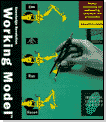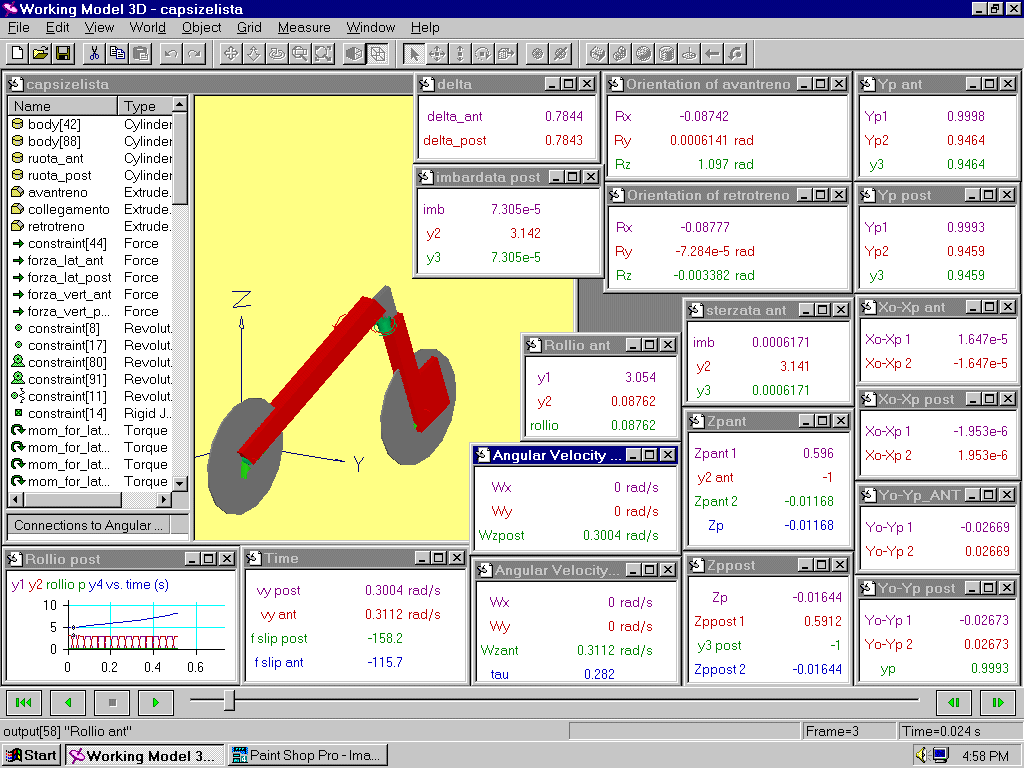Raccolta casi Working Model, visualNastran & SimWise - Motorcycle

Editorial Contact:
Paolo Lista,
Lista Studio srl®
Borgo Belvigo 33, 36016 Thiene Vi ITALY
tel/fax 0445,372479 o info@lista.it
MODAL ANALYSIS OF A MOTORCYCLE WITH WORKING MODEL 3D
Cliccare qui per il testo in italiano
Alberto Perella
Analisi modale di un motociclo con il codice multibody tridimensionale Working Model.
Università degli Studi di Padova, Facoltà di Ingegneria, Dipartimento di Ingegneria Meccanica, Anno Accademico 1996-97.
Relatori Ch.mo prof. Vittore Cossalter e ing. Mauro Da Lio.
Padua University in Italy is well known for his courses on the behaviour and design of motorcycles. Prof. Vittore Cossalter has developed a team of researchers and engineers in this specific field that have made the success of Aprilia and Cagiva motorbikes, to tell only two names. Eng. Jan Witteveen of Aprilia Racing Department has officially recognized the contribution of prof. Vittore Cossalter and Working Model for winning the World Championship last year.
Working Model 2D&3D are widely used at Padua University against competitive packages in the regular courses for mechanical engineers as well as in the Ph.D courses.
This study is an example of a simple application of Working Model 3D to analyze the mechanical behaviour of a motorcycle. It allowed to value the oscillatory modes of the Sharp’s model using the virtual prototyping software "WORKING MODEL 3D®".
Sharp has deeply studied the dynamic behaviour of motorcycles. In his paper called "The stability and control of motorcycles" he shows typical stability characteristics of a motorbike as a function of forward speed.
He obtains equations of motion by the application of Lagrange’s method. The linear differential equations describe the dynamic behaviour of a model with 4 degrees of freedom. It has freedom to sideslip, to yaw, to roll and to steer around the steering axis. The model of vehicle consists of two rigid frames joined at the steering axis with freedom of the front frame to steer relative the rear one. The wheels are rigid discs each making point contact with the road.
The solutions of eigenvalues problem shows that motorcycle has three physically significant modes : CAPSIZE, WEAVE and WOBBLE.
With WORKING MODEL 3D®, a motorbike model having the same features as the Sharp one has been created without using any external CAD. Therefore the oscillatory modes are obtained without writing the equations of motion. The model, built within WM3D, is rather simple. It consists of 4 rigid frames: the front frame, the rear frame, the front wheel and the rear one. Each frame has the same mass and inertia as the Sharp’s model.

Windows AVI file of a 3D motorbike
It has been difficult to describe the tyre-road contact forces. As a first approach, we can reduce the model with two forces. The first one is a vertical force proportional to the relative tyre-road penetration through a stiffness coefficient and to the penetration speed through a damper coefficient. The second one is a lateral force proportional to the camber angle of motorcycle and to the tyre sideslip angles. This approach was further developed till the point that a tyre add-on for Working Model was developed.
Simulations allow to know the natural frequencies and the damping by the fitting executed on the history time of the significant parameters for each oscillatory mode.
Regarding the WEAVE mode, being the oscillatory motion of the rear frame, the results obtained are very similar to Sharp’s results. The natural frequency increases from 0 Hz to 3 Hz with the forward speed of the vehicle. The mode is a bit more unstable than in the case of Sharp’s analysis.
Regarding the WOBBLE mode, which refers to the oscillatory motion of the front frame around the steering axis, results are quite different in two cases. The natural frequencies found with WM3D are smaller than those of Sharp especially at medium and high speeds. Besides the mode is unstable at low and medium speeds, only at high speeds results are similar. At those speeds the WOBBLE is stable.
The most interesting results have been obtained in the CAPSIZE mode analysis. The CAPSIZE is characteristic of motorcycles. If a motorbike doesn‘t have a person driving it will fall laterally after some time whether the motorcycle is stationary or is moving at some forward speed. This mode is non-oscillatory (f=0). Sharp shows that capsize is well damped at low speed ; on the contrary WM3D shows that the mode always is unstable especially at low speed (the motorbike falls, as in reality).
Finally some changes to the design of the vehicle in the model have been made to value effects on the oscillatory modes. Parameters changed have been : the trail, the polar moment of inertia of front and rear wheel, the steering damper, the steering head angle, the position of rear frame mass centre.
For a comparison with the teorethical work made by Sharp, please refer to:
Sharp R. S. - The stability and control of motorcycles. Jour. Mech. Engng. Sci., Vol. 13, n. 5 (1971), 316-329.
Sharp R. S. - The influence of suspension system on motorcycle weave mode oscillations. Veh. Syst. Dyn., Vol. 5 (1976), 147-154.
